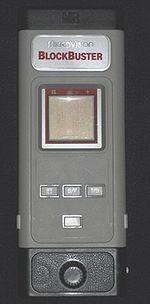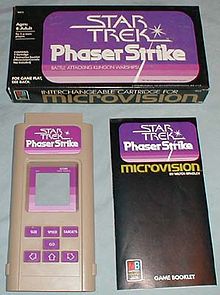- Microvision
-
For the NASDAQ company, see Microvision Incorporated.
Microvision 
Manufacturer Milton Bradley Company Generation Second generation Release date October 1979 Discontinued 1983 Media Microvision cartridges CPU Intel 8021/TI TMS1100 (on cartridge) clocked at 100 kHz Memory 32 nibbles (16 bytes) RAM, 2K ROM Display 16 × 16 resolution The Microvision was the very first handheld game console that used interchangeable cartridges. It was released by the Milton Bradley Company in November 1979.[1] The Microvision was designed by Jay Smith, the engineer who would later design the Vectrex gaming console. The Microvision's combination of portability and a cartridge-based system led to moderate success, with Smith Engineering grossing $8 million in the first year of the system's release. The handheld also appeared in the movie Friday the 13th Part 2. However, very few cartridges, a small screen, and a lack of support from established home video game companies led to its demise in 1981.[2]
Contents
Production
The first Microvision cartridges were made with both Intel 8021 and Texas Instruments TMS1100 processors. Due to purchasing issues, Milton Bradley switched to using TMS1100 processors exclusively. The TMS1100 was a more primitive device, but offered more memory and lower power consumption than the 8021. First-revision Microvisions needed two batteries due to the 8021's higher power consumption, but later units (designed for the TMS1100) only had one active battery holder. Even though the battery compartment was designed to allow the two 9-volt batteries to be inserted with proper polarity of positive and negative terminals, when a battery was forcefully improperly oriented, while the other battery was properly oriented, the two batteries would be shorted and they would overheat. The solution was to remove terminals for one of the batteries to prevent this hazard. Due to the high cost of changing production molds, Milton Bradley did not eliminate the second battery compartment, but instead removed its terminals and called it the spare battery holder.
Problems
Microvision units and cartridges are now somewhat rare.[citation needed] Those that are still in existence are susceptible to three main problems: "screen rot," ESD damage, and keypad destruction.
Screen rot
The manufacturing process used to create the Microvision's LCD was primitive by today's standards. Poor sealing and impurities introduced during manufacture has resulted in the condition known as screen rot. The liquid crystal spontaneously leaks and permanently darkens, resulting in a game unit that still plays but is unable to properly draw the screen. While extreme heat (such as resulting from leaving the unit in the sun) can instantly destroy the screen, there is nothing that can be done to prevent screen rot in most Microvisions.[citation needed]
ESD damage
A major design problem involves the fact that the microprocessor (which is inside the top of each cartridge) lacks ESD protection and is directly connected to the copper pins which normally connect the cartridge to the Microvision unit. If the user opens the protective sliding door that covers the pins, the processor can be exposed to any electric charge the user has built up. If the user has built up a substantial charge, the discharge can jump around the door's edge or pass through the door itself (dielectric breakdown). The low-voltage integrated circuit inside the cartridge is extremely ESD sensitive, and can be destroyed by an event of only a few dozen volts which cannot even be felt by the person, delivering a fatal shock to the game unit. This phenomenon was described in detail by John Elder Robison (a former Milton Bradley engineer) in his book Look Me in the Eye.
Keypad destruction
Instead of having buttons on a separate controller, the Microvision unit had a twelve-button keypad, with the switches buried under a thick layer of flexible plastic. To align the user's fingers with the hidden buttons, the cartridges had cutouts in their bottom (over the keypad). As different games required different button functions, the cutouts were covered with a thin printed piece of plastic, which identified the buttons' functions in that game. The problem with this design is that pressing on the buttons stretched the printed plastic, resulting in the thin material stretching and eventually tearing. Having fingernails exacerbated the condition. Many of the initial games were programmed to give feedback of the keypress when the key was released instead of when the key was pressed. As a result, users may press on the keypad harder because they are not being provided with any feedback that the key has been pressed. This resulted from a keypad used for prototyping being different from the production keypad; the prototyping keypad had tactile feedback upon key pressing that the production units lacked.
Technical specifications
- CPU: Intel 8021/TI TMS1100 (on cartridge)
- Screen type and resolution: 16 × 16 pixel LCD
- Register width: 4 bit (TMS1100), 8 bit (8021)
- Processor speed: 100 kHz
- RAM: 32 nybbles (16 8-bit bytes, integrated into CPU)
- ROM: 2K
- Cartridge ROM: 2K masked (integrated into CPU; each game's CPU was different)
- Video Display Processor: Custom (made by Hughes)
- Sound: Piezo beeper
- Input: Twelve button keypad, one paddle
- Power requirements: One 9 volt battery (TMS1100 processors), Two 9 volt batteries (Intel 8021 processors)
Games
- 1979
- Block Buster
- Bowling
- Connect Four
- Mindbuster
- Pinball
- Star Trek: Phaser Strike (later just Phaser Strike)
- Vegas Slots
- 1980
- Baseball
- Sea Duel
- 1981
- Alien Raiders
- Cosmic Hunter
- 1982
- Barrage (Not released - no known prototypes)
- Super Blockbuster (Released only in Europe)
See also
- Mattel Auto Race - an early handheld developed prior to Microvision.
External links
References
- ^ http://www.thepcmuseum.net/timeline.php
- ^ A Brief History of Handheld Video Games
Handheld game consoles Bandai Entex Game Park/Holdings Nintendo Game & Watch (Mini Classics) · Game Boy (Pocket · Light) · Game Boy Color · Game Boy Advance (SP · Micro · Visteon Dockable Entertainment) · Pokémon mini · Nintendo DS (Lite · DSi · DSi XL) · Nintendo 3DSNokia Sega SNK Sony Other handhelds 1970sMicrovision1980s1990s2000s2010sCategories:- Microvision
- Handheld game consoles
- Monochrome video game consoles
- 1979 introductions
- Milton Bradley games
Wikimedia Foundation. 2010.

